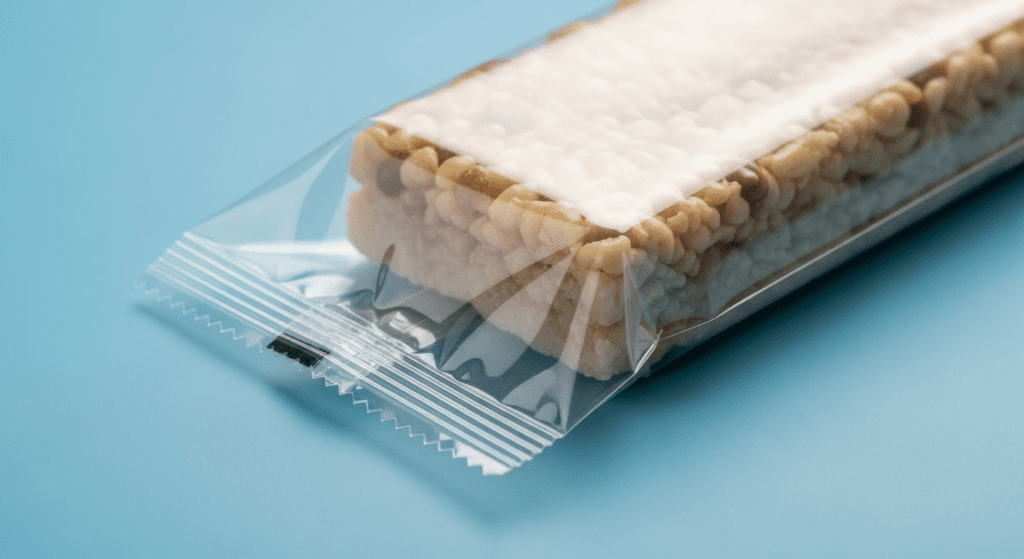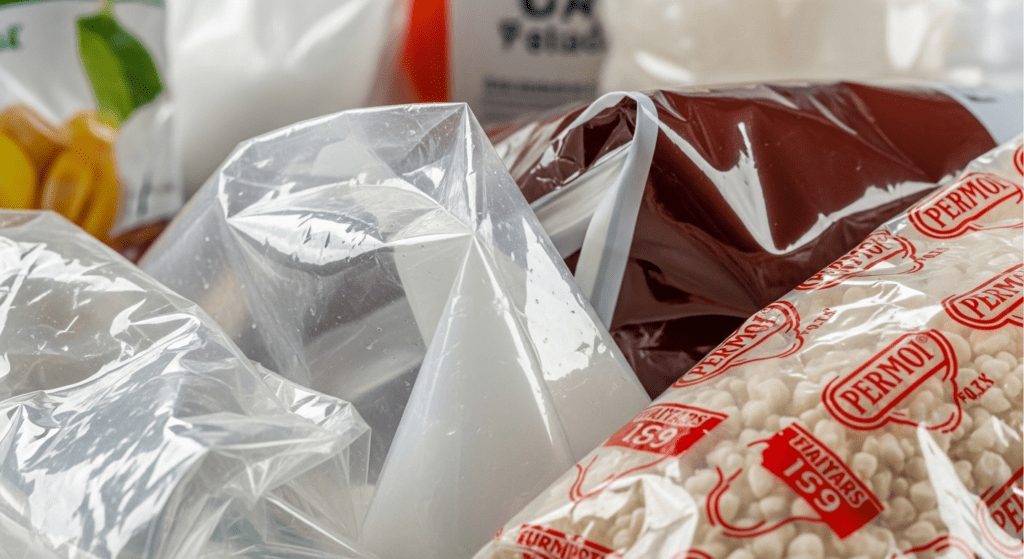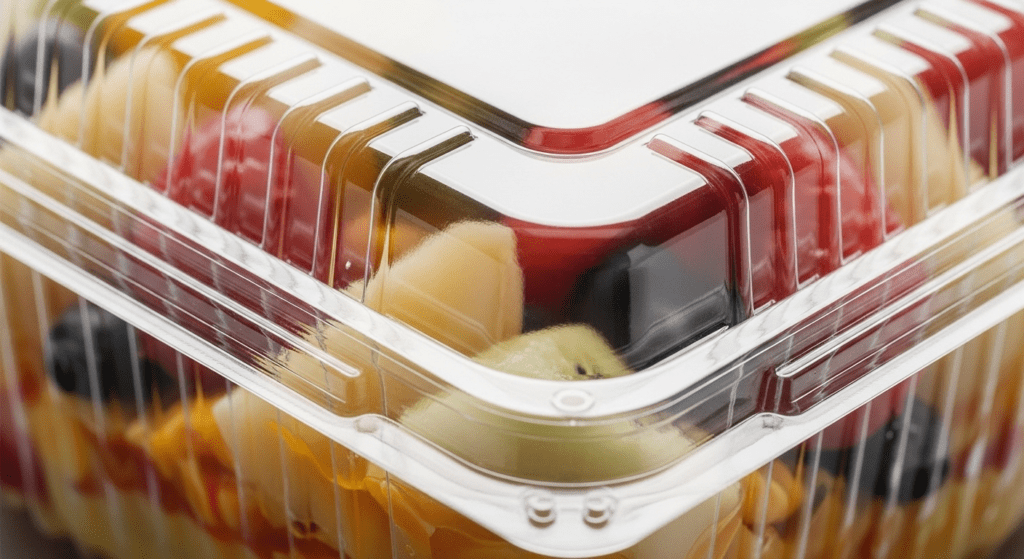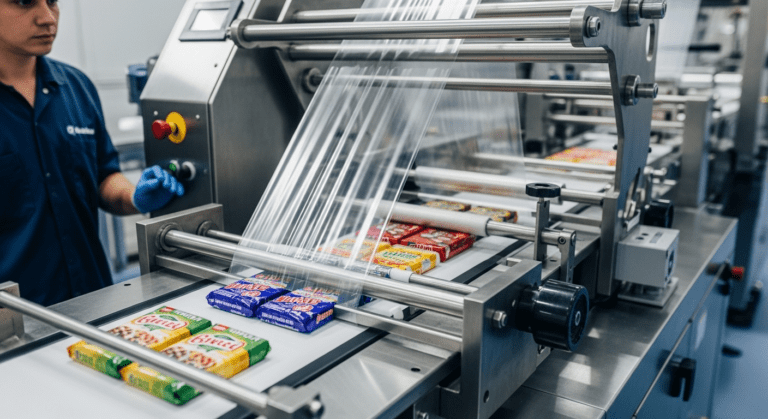Flow wrapping packaging relies on advanced polymer materials that create the perfect balance of protection, flexibility, and cost-effectiveness.
The most common materials include polypropylene, polyethylene, and polyester films, which can be used alone or combined in laminate structures. These materials protect products from moisture, oxygen, and contamination while maintaining the package’s visual appeal through clarity or printability.
The Foundational Polymers
The backbone of flow wrapping consists of three primary polymer families that each bring unique properties to packaging applications.
Polypropylene (PP)
Polypropylene stands as the workhorse of flow wrapping materials. Its excellent clarity and stiffness make it ideal for showcasing products.
- Biaxially Oriented Polypropylene (BOPP) undergoes stretching in two directions during manufacturing. This process creates a film with superior strength and barrier properties. BOPP offers exceptional clarity, making it perfect for retail packaging where product visibility matters.
- Cast Polypropylene (CPP) provides excellent heat-sealing properties. Unlike BOPP, CPP remains soft and flexible, making it ideal as a sealing layer in multi-layer structures.

Polyethylene (PE)
Polyethylene films deliver flexibility and excellent sealing characteristics across various temperature ranges.
- Low-Density Polyethylene (LDPE) offers good clarity and flexibility. Its soft nature makes it perfect for packaging delicate items that need cushioning protection.
- Linear Low-Density Polyethylene (LLDPE) provides enhanced puncture resistance compared to LDPE. This material stretches well without tearing, making it ideal for irregularly shaped products.
- High-Density Polyethylene (HDPE) brings superior moisture barrier properties to flow wrapping. Though less clear than LDPE, HDPE excels in applications requiring strong moisture protection.

Polyester (PET)
Polyester films deliver exceptional strength and temperature resistance. PET maintains its properties across a wide temperature range, from freezer storage to microwave heating.
Its excellent barrier properties protect against both oxygen and moisture penetration.

Laminate Structure
Modern flow wrapping often combines multiple materials to achieve optimal performance. These laminate structures leverage the best properties of each component material.
Two-Layer (Duplex) Laminates
Two-layer laminates provide cost-effective solutions for many packaging needs.
- PET/PE combines polyester’s strength with polyethylene’s sealing ability. This structure works well for snack foods and confectionery.
- BOPP/CPP pairs the clarity of oriented polypropylene with the heat-sealing properties of cast polypropylene. Bakery products often use this combination.
- BOPP/PE merges BOPP’s stiffness with PE’s flexibility. This laminate suits products requiring good machinability and moderate barrier properties.
- PA/PE combines polyamide’s excellent oxygen barrier with polyethylene’s moisture protection. Cheese and processed meat packaging frequently employs this structure.
Three-Layer (Triplex) and Multi-Layer Laminates
Complex packaging requirements often demand three or more layers.
- PET/ALU/PE incorporates aluminum foil for ultimate barrier protection. Coffee and pharmaceutical products benefit from this near-absolute barrier to light, oxygen, and moisture.
- PET/MET PET/PE uses metallized polyester instead of aluminum foil. This structure provides excellent barriers while maintaining some flexibility and lower cost than foil laminates.
Gas Barriers
Oxygen-sensitive products require specialized barrier materials to maintain freshness.
- Ethylene Vinyl Alcohol (EVOH) provides exceptional oxygen barrier properties. However, EVOH loses effectiveness when exposed to moisture, so it typically sits between protective layers.
- Polyamide (PA / OPA) offers good oxygen barrier properties along with excellent puncture resistance. Oriented polyamide (OPA) enhances these properties through biaxial stretching.
Moisture Barriers
Protection from humidity remains crucial for many flow-wrapped products.
- Metallized Films (MET) feature a thin aluminum coating on plastic substrates. This metallization dramatically improves moisture and oxygen barrier properties while maintaining flexibility.
- Aluminum Foil (Alu) provides the ultimate moisture barrier. Even thin gauges of aluminum completely block water vapor transmission, though at higher cost and reduced flexibility compared to plastic films.


